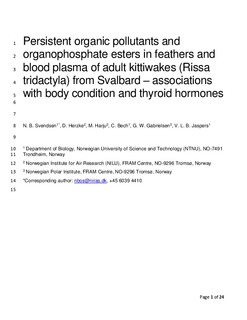| dc.contributor.author | Svendsen, Niels Borup | |
| dc.contributor.author | Herzke, Dorte | |
| dc.contributor.author | Harju, Mikael | |
| dc.contributor.author | Bech, Claus | |
| dc.contributor.author | Gabrielsen, Geir W. | |
| dc.contributor.author | Jaspers, Veerle | |
| dc.date.accessioned | 2019-03-29T08:08:14Z | |
| dc.date.available | 2019-03-29T08:08:14Z | |
| dc.date.created | 2018-03-07T09:22:12Z | |
| dc.date.issued | 2018 | |
| dc.identifier.citation | Environmental Research. 2018, 164 158-164. | nb_NO |
| dc.identifier.issn | 0013-9351 | |
| dc.identifier.uri | http://hdl.handle.net/11250/2592319 | |
| dc.description.abstract | Polychlorinated biphenyls (PCBs), polybrominated diphenyl ethers (PBDEs), organochlorine pesticides (OCPs) and organophosphate esters (OPEs) were assessed in blood plasma and feathers of 19 adult black-legged kittiwakes (Rissa tridactyla) breeding in two colonies (Blomstrandhalvøya and Krykkjefjellet) at the Arctic archipelago, Svalbard. Potential associations with body condition index (BCI) and thyroid hormones were investigated. All compound classes were detected in both blood plasma and feathers, but due to low sample size and volumes, OPEs could only be quantified in four individuals, warranting larger follow-up studies. Kittiwakes breeding at Blomstrandhalvøya had significantly higher concentrations of organic pollutants in blood plasma than kittiwakes breeding at Krykkjefjellet (p < 0.001). Concentrations in blood plasma and feathers did not significantly correlate for any of the investigated compounds, and feather concentrations did not differ significantly between the colonies. This suggests that pollutant levels in adult kittiwake feathers do not reflect local contamination at breeding sites and are as such not useful to monitor local contamination at Svalbard. Significant negative associations between BCI and most pollutants were found in both populations, whereas significant correlations between the BCI, the ratio of total triiodothyronine to free triiodothyronine (TT3:fT3), and several pollutants were only found for kittiwakes from Blomstrandhalvøya (all r ≥ −0.60 and p ≤ 0.05). This indicates that higher levels of circulating pollutants during the breeding period covary with the TT3: fT3 ratio, and may act as an additional stressor during this period. | nb_NO |
| dc.language.iso | eng | nb_NO |
| dc.publisher | Elsevier | nb_NO |
| dc.rights | Attribution-NonCommercial-NoDerivatives 4.0 Internasjonal | * |
| dc.rights.uri | http://creativecommons.org/licenses/by-nc-nd/4.0/deed.no | * |
| dc.title | Persistent organic pollutants and organophosphate esters in feathers and blood plasma of adult kittiwakes (Rissa tridactyla) from Svalbard – associations with body condition and thyroid hormones | nb_NO |
| dc.type | Journal article | nb_NO |
| dc.type | Peer reviewed | nb_NO |
| dc.description.version | acceptedVersion | nb_NO |
| dc.source.pagenumber | 158-164 | nb_NO |
| dc.source.volume | 164 | nb_NO |
| dc.source.journal | Environmental Research | nb_NO |
| dc.identifier.doi | 10.1016/j.envres.2018.02.012 | |
| dc.identifier.cristin | 1571018 | |
| dc.description.localcode | © 2018. This is the authors’ accepted and refereed manuscript to the article. Locked until 27.2.2020 due to copyright restrictions. This manuscript version is made available under the CC-BY-NC-ND 4.0 license http://creativecommons.org/licenses/by-nc-nd/4.0/ | nb_NO |
| cristin.unitcode | 194,66,10,0 | |
| cristin.unitname | Institutt for biologi | |
| cristin.ispublished | true | |
| cristin.fulltext | postprint | |
| cristin.qualitycode | 2 | |

